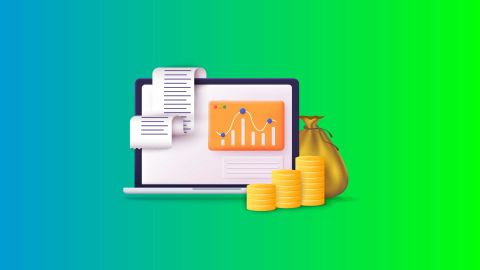Running a business smoothly requires more than just a great product or service—it demands consistent cash flow and financial flexibility. That’s where current assets come in. These assets represent everything a company can quickly convert into cash or use within a year, making them the backbone of daily operations.
From paying salaries to managing inventory or taking on new business opportunities, current assets give businesses the breathing room to stay agile and resilient. If you’ve ever wondered what falls under current assets and why they matter so much, this article breaks it all down in a simple and practical way—no accounting degree needed. Just like current assets help businesses stay liquid and responsive, a well-diversified portfolio of mutual funds can help individuals maintain financial flexibility in uncertain times. Compare mutual fund options now!
Let’s start by understanding what current assets really mean.
What are current assets?
Current assets, also known as liquid assets, include everything a company expects to use, sell, or turn into cash within one year. Think of them as the financial fuel that keeps a business running day to day. These typically include:
Cash and cash equivalents: Money on hand or in the bank, ready for immediate use.
Accounts receivable: Payments expected from customers who bought on credit.
Inventory: Goods available for sale.
Short-term investments: Financial instruments that can be quickly liquidated.J
Just as companies rely on liquid assets for agility, mutual funds offer individuals a way to stay flexible while building long-term wealth. Explore top-performing mutual funds!
Examples of current assets
Not all assets are the same, and current assets stand out for their liquidity. Here are some key examples:
Cash and cash equivalents: Includes physical cash, checking account balances, and short-term deposits.
Short-term investments: Such as treasury bills or money market funds that are easily convertible to cash.
Accounts receivable: Amounts due from customers who’ve bought goods or services on credit.
Inventory: All raw materials, work-in-progress goods, and finished products ready for sale.
Prepaid expenses: Advance payments for services like rent or insurance, which will be utilised within the year.
Marketable securities: Liquid investments like government bonds or commercial paper.
Notes receivable: Promissory notes due within one year.
Supplies and other quick assets: Operational materials expected to be consumed within the fiscal year.
What can you do with current assets?
Current assets aren’t just numbers on a balance sheet—they're what help a business keep running day to day. Whether it’s paying salaries, restocking shelves, or clearing short-term dues, these assets provide the liquidity to keep things moving.
Let’s say a company needs to buy raw materials, settle a vendor bill, or even jump on a time-sensitive growth opportunity. It taps into its current assets—like cash, receivables, or short-term investments—to do so. These assets play a crucial role in keeping daily operations smooth and uninterrupted.
They can also support expansion plans, from upgrading equipment to opening new branches, and help reduce financial stress by covering debt repayments when needed. In short, effective use of current assets keeps the business agile and ready to act.
Types of current assets
Every current asset serves a unique purpose, but together, they form a financial safety net for businesses. Let’s walk through each type:
1. Cash and cash equivalents
This is the most liquid asset—think physical cash, money in bank accounts, and short-term deposits that can be converted quickly to cash. It’s the go-to reserve for urgent payments.
2. Marketable securities
These are investments that can be sold quickly with minimal loss in value. Examples include government bonds and treasury bills. They're useful when you need quick access to funds without disrupting core operations.
3. Accounts receivable
This is the money customers owe you. When a sale is made on credit, it shows up here. It represents future cash that’s expected to come in soon and helps predict near-term liquidity.
4. Inventory
All the goods a business holds—raw materials, items in production, and finished goods ready for sale—are part of inventory. Managing this well ensures you’re not tying up too much money in unsold stock.
5. Prepaid expenses
These are advance payments made for services you’ll receive later, like insurance or rent. While not convertible to cash, they count as assets because they reduce future expenses.
Just like businesses diversify their current assets to balance liquidity and utility, investors can diversify their portfolios using mutual funds that align with their short-term and long-term goals. Compare mutual fund options now!
Formula for current assets
To calculate total current assets, you simply add up the value of all individual short-term assets. The common formula is:
Current Assets = Cash and Cash Equivalents + Accounts Receivable + Marketable Securities + Inventory + Prepaid Expenses + Other Liquid Assets
These figures usually appear at the top of the balance sheet—arranged in descending order of liquidity. Analysts and investors use this number to evaluate a company’s ability to meet its short-term financial obligations. It also feeds into important financial ratios like the current ratio and quick ratio, offering deeper insights into cash flow health and working capital.
How to calculate current assets
Figuring out a company’s current assets is pretty straightforward—it’s all about summing up what can be turned into cash within a year. You take the value of each liquid or short-term asset, add them together, and get a snapshot of the business’s immediate financial strength.
Here’s how it looks in practice:
| Current Asset Type | Amount (Rs.) |
| Cash and Cash Equivalents | 1,00,000 |
| Marketable Securities | 50,000 |
| Accounts Receivable | 75,000 |
| Inventory | 1,25,000 |
| Prepaid Expenses | 20,000 |
| Total Current Assets | 3,70,000 |
So, in this example, the company has Rs. 3.7 lakh in assets it can use soon to manage operations, pay bills, or reinvest. This total helps investors and business owners alike understand how ready the business is to handle short-term needs.
Key characteristics of current assets
Current assets share some important traits that make them unique on a company’s balance sheet. First, they’re tangible or near-cash resources expected to be consumed or converted into cash within a year. They’re often involved in the day-to-day functioning of the business—funding payroll, buying supplies, and keeping things running smoothly.
Unlike fixed assets, current assets don’t depreciate. Their value comes from how quickly and efficiently they can be put to use. That’s why they’re critical indicators of a company’s short-term financial health.
Components of current assets
When looking at a company’s financial position, current assets paint a clear picture of how prepared it is to meet near-term obligations. These include:
1. Inventory
Inventory includes everything from raw materials to finished goods ready for sale. Proper inventory management helps businesses avoid excess stock or shortages, saving on storage and ensuring timely order fulfilment.
2. Accounts receivable
These are the amounts due from customers who’ve purchased on credit. Managing receivables well means faster collections, better cash flow, and fewer overdue payments clogging up your finances.
3. Prepaid expenses
These are advance payments for services or utilities that will be used over time—like rent or insurance. They’re listed as current assets because they offer future value, even though the cash has already been paid out.
Usage of current assets
Current assets are the backbone of a business’s daily operations. Whether it’s paying suppliers, fulfilling customer orders, or covering short-term expenses, these assets ensure the business doesn’t miss a beat.
Take inventory, for instance—it helps fulfil customer orders on time. Accounts receivable, on the other hand, represent future cash inflow from sales already made. Prepaid expenses save costs down the line by locking in essential services in advance.
Efficient use of current assets can lead to smoother cash flow, timely payments, and opportunities to reinvest profits into the business. Simply put, they keep the engine running while giving the company room to grow and adapt. Just as businesses rely on current assets for flexibility and daily cash flow, mutual fund investors can use short-term schemes to manage liquidity while staying invested. Explore top-performing mutual funds!
How do investors use current assets?
For investors and creditors, current assets are a go-to metric to judge a company’s short-term financial health. They look at the total value of these assets to understand how easily a company can handle everyday expenses and upcoming payments.
A strong current asset position shows that a business can settle its bills and loans without scrambling for funds. If needed, the company can liquidate some of these assets quickly, which helps it stay operational and even pounce on sudden growth opportunities.
That’s why current assets are often at the centre of financial analysis—they reflect both stability and flexibility.
Financial ratios that use current assets and their components
Current assets play a big role in assessing a company’s liquidity, and there are several financial ratios built around them. These ratios help answer a crucial question: can the company cover its short-term liabilities without raising new capital?
1. Cash ratio
This is the most conservative of the lot. It only considers cash and cash equivalents to measure the ability to pay short-term liabilities.
Formula: Cash Ratio = Cash and Cash Equivalents ÷ Current Liabilities
2. Current ratio
This ratio takes all current assets into account. It’s a broader measure of liquidity and gives an overall view of financial health.
Formula: Current Ratio = Current Assets ÷ Current Liabilities
3. Quick ratio
Also called the acid-test ratio, this one excludes inventory since it’s not as easy to liqudate quickly. It focuses on the most accessible assets.
Formula: Quick Ratio = (Cash and Cash Equivalents + Marketable Securities + Accounts Receivable) ÷ Current Liabilities
Why are current assets important for a business?
Current assets are more than just numbers on a balance sheet—they’re what keep a business running smoothly. These are the resources that can be turned into cash quickly, allowing companies to stay agile and meet everyday financial responsibilities.
1. Ensuring operational efficiency:
From paying salaries to keeping the lights on, current assets make sure the daily operations don’t hit a roadblock. Inventory helps meet customer demands, while cash reserves cover recurring expenses like rent and utilities.
2. Meeting financial obligations:
Timely collection of accounts receivable helps businesses maintain healthy cash flow. That, in turn, allows them to pay off short-term debts without stress.
3. Responding to market fluctuations:
When the market shifts—be it sudden demand or a slowdown—businesses with solid current assets can adjust quickly. Liquidity brings flexibility.
4. Pursuing growth opportunities:
Want to launch a new product or expand to a new region? Current assets provide the funds to make bold moves without jeopardising ongoing operations.
5. Enhancing financial stability:
A strong current asset base builds confidence. It signals to investors and creditors that the company is well-positioned to survive downturns and capitalise on opportunities.
How to increase your current assets
Boosting current assets isn’t always easy—especially when you're juggling operating costs, limited resources, and evolving market needs. But there are practical steps businesses can take to strengthen liquidity.
Liquidate non-core assets: Sell off excess inventory or short-term investments that aren't actively contributing to revenue.
Accelerate collections: Improve your invoicing and follow-up processes to bring in receivables faster.
Cut unnecessary costs: Streamline operations, renegotiate supplier contracts, and identify expense leaks.
Manage inventory better: Use forecasting tools and supplier deals to avoid overstocking or running out.
Negotiate payment terms: Ask vendors for longer payment cycles while taking advantage of early payment discounts when possible.
Increase revenue: Drive more sales to create consistent cash inflows.
Make smart short-term investments: Consider liquid instruments that offer returns without locking in your capital.
These strategies not only boost current assets but also improve your ability to handle short-term needs without external funding.
Differences between current assets and noncurrent assets
| Aspect | Current Assets | Non-Current Assets |
| Definition | Assets expected to be converted to cash or used within a year | Assets with a useful life of more than one year |
| Examples | Cash, marketable securities, inventory, accounts receivable | Long-term investments, land, property, plant, equipment |
| Valuation | Typically valued at market prices | Valued at cost, less depreciation |
| Liquidity | Highly liquid and easily convertible to cash | Less liquid, not easily converted to cash |
| Purpose | Used for short-term obligations and operations | Used for long-term investments and expansion |
| Financial Ratio Impact | Affects liquidity ratios like current and quick ratio | Impacts solvency ratios and asset turnover |
Key takeaways
Definition: Current assets include all short-term assets that a business can convert to cash within a year, like inventory, receivables, and prepaid expenses.
Components: Key items include cash, accounts receivable, inventory, marketable securities, and other liquid resources.
Significance: They determine how efficiently a business can operate day-to-day and handle sudden financial requirements.
Conclusion
Understanding and managing current assets is crucial to a business’s short-term success and long-term stability. Whether it’s covering payroll, paying suppliers, or funding small expansion plans, these assets provide the necessary liquidity. With tools like the cash ratio, current ratio, and quick ratio, companies can assess their ability to meet obligations without overextending themselves. In the end, a strong current asset position signals not just survival—but the potential to thrive. For investors looking to explore mutual fund investments, the Bajaj Finserv Mutual Fund Platform is a robust choice, with over 1000+ mutual fund schemes listed on the Bajaj Finserv Platform, offering diverse investment opportunities tailored to different financial goals along with comparing mutual funds.
Essential tools for all mutual fund investors
| Mutual Fund Calculator | Lumpsum Calculator | Systematic Investment Plan Calculator | Step Up SIP Calculator |
| SBI SIP Calculator | HDFC SIP Calculator | Nippon India SIP Calculator | ABSL SIP Calculator |








